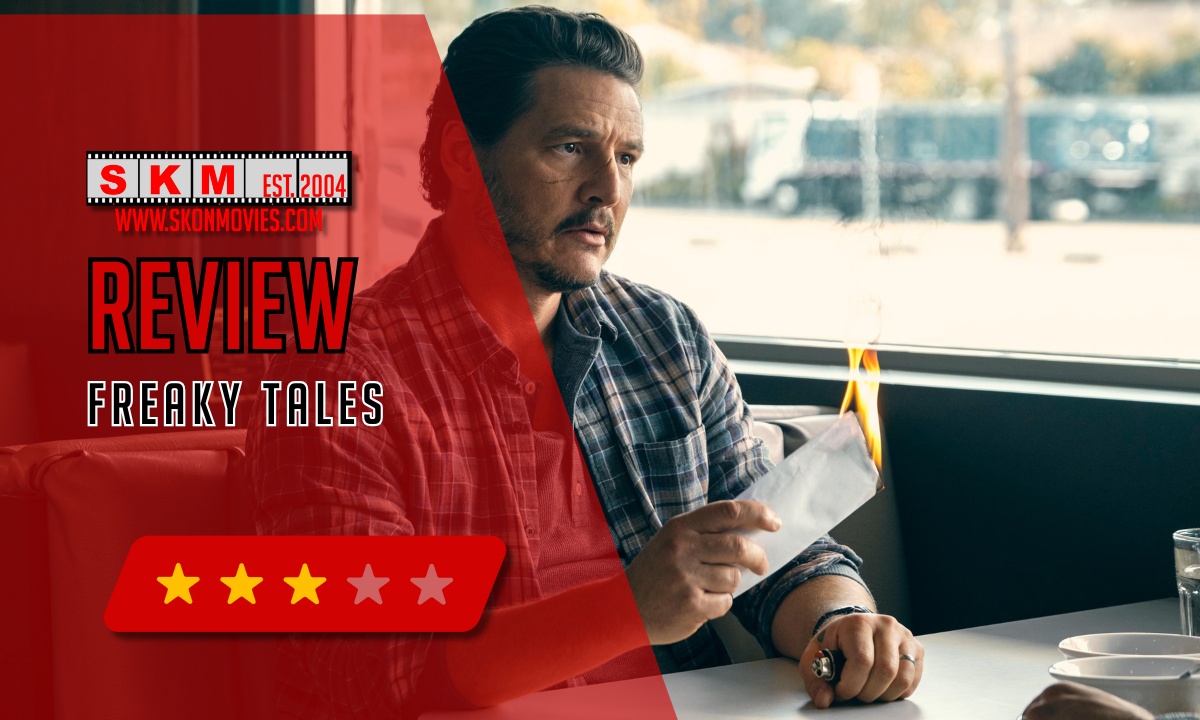Freaky Tales
Content Advisory: Sexual Harassment, Excessive or gratuitous violence, Racism, Homophobia
Cosmic forces assist multiple individuals in 1987 Oakland in Freaky Tales. Oakland in 1987 was hella wild, and cosmic green lightning strikes down and gives ordinary people the power of Psytopics. In Chapter 1: Strength in Numbers Tina (Ji-young Yoo) and Lucid (Jack Champion) join their punk rock friends in a gang war against Neo-Nazis. In Chapter 2: Don’t Fight the Feeling, ice cream shop employees Entice (Normani) and Barbie (Dominique Thorne) turn the tables in a rap battle against Too $hort (DeMario Symba Driver). In Chapter 3: Born to Mack, the retirement plans of mob enforcer Clint (Pedro Pascal) take a tragic turn when one of his victims comes seeking revenge. Finally, in the final chapter, The Legend of Sleepy Floyd, a botched robbery results in basketball star Eric “Sleepy” Floyd (Jay Ellis) taking out bloody revenge on corrupt detective The Guy (Ben Mendelsohn).
Freaky Tales Synopsis
Freaky Tales is a 1980s-set anthology film written and directed by Anna Boden and Ryan Fleck (Captain Marvel). The film tells four stories set in Oakland in 1987, with the connecting element being a cosmic green lightning that gives ordinary individuals superhuman abilities. Each of the stories is loosely interconnected, sharing characters and events.

The ensemble cast of Freaky Tales is led by the trio of Pedro Pascal (Gladiator II, Drive-Away Dolls) as retiring enforcer Clint, Ben Mendelsohn (Ready Player One) as a corrupt detective known only as The Guy, and Jay Ellis (Top Gun: Maverick) as basketball star Sleepy Floyd. The film also features Jack Champion (Avatar: The Way of Water, Scream VI), Dominique Thorn (Black Panther: Wakanda Forever), and a surprise A-lister cameo that I don’t want to spoil here.
My Thoughts on Freaky Tales
One of the first things to cross my mind while watching Freaky Tales is that the film is trying too hard to mimic a 1980s VHS aesthetic, complete with poor tracking. The film is also incredibly inconsistent with its visuals, depicting the first chapter in 4:3 aspect ratio, presumably solely for a sight gag during a very comicbook-style fight scene, which at one point sees a blood splatter going outside of the frame. The VHS look of Freaky Tales slowly goes away as the rest of the film moves to a typical HD framing.
Freaky Tales also suffers from a problem that is inherent to most anthology films: how only a few of the segments are worth checking out. The best segment of Freaky Tales is undoubtedly the climactic story, The Legend of Sleepy Floyd, which features a very violent scene of the vengeful NBA player dispatching a gang with a sword and lots of knives. The least compelling segment of the film is the second chapter Don’t Fight the Feeling, which seemingly feels the need to shoehorn a battle-rap sequence in what is otherwise an action film.
There are many obvious influences seen throughout Freaky Tales, including Walter Hill’s The Warriors and David Cronenberg‘s Scanners. There is also a recurring gag where a couple of the segments begin with the characters debating the ending of The Lost Boys. However, the most obvious influence on Freaky Tales is Stranger Things, though the film never reaches the level of that show.
The most enjoyable moment of Freaky Tales comes around the midway point when Pedro Pascal’s Clint enters a video store and is greeted by a trivia-spouting clerk played by a very familiar actor. While it’s pretty easy to look up who this actor is, I don’t want to reveal it since I was truly pleasantly surprised by his appearance in Freaky Tales. Sadly, the rest of the film doesn’t come up to par with that one moment.
Freaky Tales might have come off better if Anna Boden and Ryan Fleck ditched the anthology format and developed that latter two, and vastly superior, segments into a linear narrative. As it stands, Freaky Tales is trying too hard to be a 1980s-influenced sci-fi action adventure. While the film has individual segments that stand out, the film as a whole is somewhat mediocre.

